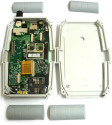MontaVista spins MID stack
February 16, 2009 [Updated: Feb. 17, 2009] — MontaVista will demonstrate a Linux distribution for mobile Internet devices (MIDs). The “Montabello” stack builds upon its Mobilinux distribution with MID-focused middleware and applications, and offers extended battery life, fast boot-up, and “seamless”… (more…)
[Updated: Feb. 17, 2009] — MontaVista will demonstrate a Linux distribution for mobile Internet devices (MIDs). The “Montabello” stack builds upon its Mobilinux distribution with MID-focused middleware and applications, and offers extended battery life, fast boot-up, and “seamless”… (more…)
 Foreword — Glenda Dorchak joined embedded and real-time virtualization specialist VirtualLogix in January, taking over the CEO role. Dorchak has 30 years of tech industry management experience, most recently at Windows Mobile device specialist Intrinsyc, and plans to focus the company on high-growth…
Foreword — Glenda Dorchak joined embedded and real-time virtualization specialist VirtualLogix in January, taking over the CEO role. Dorchak has 30 years of tech industry management experience, most recently at Windows Mobile device specialist Intrinsyc, and plans to focus the company on high-growth…  Qualcomm has announced four mobile chipsets, three with Scorpion cores based on ARM Ltd.'s ARMv7 architecture. The ARM11-based MSM7227 targets sub-$150 smartphones, listing specific support for Google's Android, while the Scorpion-based MSM8260, MSM8660, and MSM8270 target high-end devices with HD video, the company says.
Qualcomm has announced four mobile chipsets, three with Scorpion cores based on ARM Ltd.'s ARMv7 architecture. The ARM11-based MSM7227 targets sub-$150 smartphones, listing specific support for Google's Android, while the Scorpion-based MSM8260, MSM8660, and MSM8270 target high-end devices with HD video, the company says.  Taiwanese network-appliance integrator AR Infotek has announced a Linux-ready network security appliance with a cryptographic security engine. Based on an Intel Pentium M EP80579 (“Tolapai”) SoC clocked up to 1.2GHz, the Teak 3020 sports four gigabit Ethernet ports and dual USB ports.
Taiwanese network-appliance integrator AR Infotek has announced a Linux-ready network security appliance with a cryptographic security engine. Based on an Intel Pentium M EP80579 (“Tolapai”) SoC clocked up to 1.2GHz, the Teak 3020 sports four gigabit Ethernet ports and dual USB ports.  Esmertec, a Swiss firm specializing in Android and Java virtual machines, is acquiring Purple Labs, a French vendor of mobile stacks compatible with the LiMo Platform. In a stock deal worth about 19.7 million shares, the two European companies will be renamed as “Myriad Group AG.”
Esmertec, a Swiss firm specializing in Android and Java virtual machines, is acquiring Purple Labs, a French vendor of mobile stacks compatible with the LiMo Platform. In a stock deal worth about 19.7 million shares, the two European companies will be renamed as “Myriad Group AG.” Location-based services (LBS) software vendor Telmap announced it has ported its mobile navigation software to Linux and the Moblin distribution for mobile Internet devices (MIDs). Telmap will demonstrate “Telmap Navigator” running on Intel Atom-based Moblin MIDs at next week's Mobile World Congress in Barcelona.
Location-based services (LBS) software vendor Telmap announced it has ported its mobile navigation software to Linux and the Moblin distribution for mobile Internet devices (MIDs). Telmap will demonstrate “Telmap Navigator” running on Intel Atom-based Moblin MIDs at next week's Mobile World Congress in Barcelona.  Garmin and AsusTek (Asus) have announced a jointly developed smartphone that offers Garmin's “Nuvi” location-based services (LBS) features and runs Linux. The Nuvifone G60 offers a 3.5-inch touchscreen, 4GB of flash, GSM and HDSPA connectivity, WiFi, Bluetooth, GPS, and a 3-Mpixel camera with geotagging.
Garmin and AsusTek (Asus) have announced a jointly developed smartphone that offers Garmin's “Nuvi” location-based services (LBS) features and runs Linux. The Nuvifone G60 offers a 3.5-inch touchscreen, 4GB of flash, GSM and HDSPA connectivity, WiFi, Bluetooth, GPS, and a 3-Mpixel camera with geotagging.  The EPA may re-consider its exemption of “Data Acquisition Mode” (DAM) states from the sleep-mode requirements associated with its Energy Star ratings. So it told noted cryptographer Martin Hellman, who informed the EPA his Linux-based Sony HDTV consumed 150 times its advertised standby power budget.
The EPA may re-consider its exemption of “Data Acquisition Mode” (DAM) states from the sleep-mode requirements associated with its Energy Star ratings. So it told noted cryptographer Martin Hellman, who informed the EPA his Linux-based Sony HDTV consumed 150 times its advertised standby power budget.  The Open Source Automation Development Lab (OSADL) announced that the PREEMPT_RT patches have been stabilized with the mainline Linux 2.6.26 kernel. The newly available “latest stable” kernel is said to achieve latency as low as 39 microseconds, while inheriting several interesting new 2.6.26 kernel features.
The Open Source Automation Development Lab (OSADL) announced that the PREEMPT_RT patches have been stabilized with the mainline Linux 2.6.26 kernel. The newly available “latest stable” kernel is said to achieve latency as low as 39 microseconds, while inheriting several interesting new 2.6.26 kernel features.  An open source hacker community has launched an online store to sell home-made gizmos, including a GPS-equipped baseboard (pictured) for the Linux-ready Gumstix Verdex processor module.
An open source hacker community has launched an online store to sell home-made gizmos, including a GPS-equipped baseboard (pictured) for the Linux-ready Gumstix Verdex processor module.  LinuxDevices founder Rick Lehrbaum has set out to build an HD-capable, on-demand Internet set-top box, just for fun. He has written a detailed article on his current system, which combines Ubuntu, Boxee, custom modelines, and some xrandr shell magic for enjoyable Internet TV viewing, he says.
LinuxDevices founder Rick Lehrbaum has set out to build an HD-capable, on-demand Internet set-top box, just for fun. He has written a detailed article on his current system, which combines Ubuntu, Boxee, custom modelines, and some xrandr shell magic for enjoyable Internet TV viewing, he says.